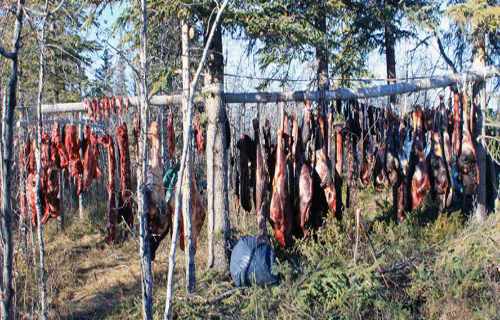It’s so easy to preserve food with a fridge. But if you don’t have electricity, because of some big disaster or resource depletion, how would you handle preserving meat?
In winter it is relatively simple, because your whole environment is one big fridge. But what to do to prevent meat from getting rotten during warm months? What would you do to store a meat for at least one year?
Store it “on the hoof”
That is to say that if you want to “store” pork for several months, perhaps you should wait until the beginning of winter for slaughter and processing. Or alternatively, don’t raise meat animals that provide so much meat that you have to store it. Chickens would fit the bill, since you can process a single chicken, prepare a meal with the mean, make soup (possibly canning it) from the leftovers, and not have to worry so much about preserving the meat. Or make arrangements so that a larger animal (e.g. in the case where you’re keeping dairy animals like goats or cattle) can be shared among enough people so that the meat is used immediately.
Canning
It’s energy intensive up-front, but meat can be home canned and preserved for extended periods of time (possibly longer than salting, smoking, or drying).
In today’s world, it has become extremely important to prepare your family for disasters. Even something small like an ice storm could knock out power and close roadways for days at a time. To prepare for events like this, many people are beginning to realize the importance of having local food sources and keeping stored food on hand. Unfortunately, even if you raise your own animals, preserving meat the modern way involves a large, reliable source of electricity.
Thankfully, you don’t have to be a farmer or even an off-grid homesteader to put up meat using reliable methods. There are many ways of preserving meat without electricity that are feasible for those with root cellars in old farmhouses and those living in inner city apartments.
1. Smoking
Smoking is one of the oldest methods of preserving meat. It was most commonly used in areas that had too much humidity to air dry or dehydrate meat (without the aid of a modern dehydrator of course). It can be really tasty. However, modern recommendations are to consume smoked meat sparingly as smoke contains carcinogens. That being said, it may still be a good choice for some of your harvest or an emergency situation. Smokers can be purchased or made at home. Obviously, this method is better suited to those with access to a backyard.
2. Curing (salting)
Curing meat is another old preservation method that is still used today. It involves quite a bit of time and effort but it’s how traditional favorites like bacon and pastrami were preserved. It’s also a cheap and easy process to master perfect for the new homesteader. You will need a cool area and a place where meats can be hung out of the way. Some curing recipes are used in combination with smoking for flavor.
3. Brining
It’s a very simple and is a traditional method of preservation. Brine is typically a simple mixture of water, sugar, and salt. The meat is preserved by being weighed down in a crock completely surrounded by brine. As with curing, you’ll need a cool area, and if you’re doing any large quantities be sure you have room to store your crocks.
4. Pressure Canning
First, it’s important to note that you absolutely cannot water bath can meat! It’s not acidic enough. However, if you have a pressure canner any type of meat can be easily pressure canned. This is probably one of the most popular methods today as once the meat is canned it requires no further work. You just re-heat it when you’re ready to eat and the jars are portable. Pressure canners are affordable, perfect for even apartment homesteaders, and are great for putting up vegetable harvests too.
5. Dehydrating
This is probably one of the easiest, healthiest methods of storing meat (and vegetables too). Meat can be dried with the help of an electric dehydrator or a solar dehydrator. If you opt for an electric dehydrator, it’s probably best to purchase a larger one. Even though they’re cheaper, constantly running a small one trying to preserve all your food will take a lot of electricity. Solar dehydrators obviously have the benefit of not requiring electricity, but they are weather dependent. Solar dehydrators can be purchased or there’s a lot of DIY plans available online. With either you’ll need to make sure you’re meat is fully dried. If it’s left too moist it can mold.
6. Storing in Lard
This method may be very practical for those butchering an animal with a lot of fat. Both raw and cooked meat can be layered in a crock with melted lard. The lard prevents the growth of bacteria by keeping air from getting to the meat. It’s a cheap and effective storage method and involves no equipment.
8. Keep Heritage Livestock
For those who keep livestock, obviously you may want to consider heritage breeds. Unlike modern livestock, heritage breeds are typically smaller. This was because a family would be able to use most or all of the animal before it went bad without having to preserve it. With the advent of refrigeration and factory farms, livestock was bred to be bigger and bigger which is not necessarily helpful for the small homestead. Some heritage livestock was also bred to have a higher fat content than their modern counterparts, which can be helpful in preservation.
9. Natural Refrigeration/Freezing
Though this is not the most reliable method, it is worth mentioning. In colder climates, it’s possible to store meat outside in the winter, but you’ll need to keep an eye on the thermometer if the weather warms up. You’ll also need to keep it in a secure building or container. Leaving meat out, frozen or not, can attract predators. Some people also have used hand dug wells as refrigerators. Simply put the meat in water tight jars and sink them in the well for short term refrigeration. Again, you’ll need to watch the temperature carefully.
Producing a lot of food is often one of a homesteader’s first goals, but if you rely on electricity to keep your harvest, you risk losing it all to a power outage. Knowing how to keep your food good when the power goes out using a combination of modern and traditional techniques can save you money and keep your family healthy.
SUN/AIR DRYING OF MEATS
While still used today in some countries, open air-drying of meats is not nearly as efficient as heat drying methods and it has certain disadvantages. One problem with this method is contamination. Insects and birds along with windblown debris can contaminate the meats while it is drying. Cheesecloth or similar material can be used along with a salt solution of 14 percent to help cure the meat and to repel insects to some extent. The meat is dipped in the salt solution and then hung vertically in most cases.
Typically, the meat is cut into strips and suspended so the air/sun can reach all sides. This method is not recommended unless you have experience with air-drying or there is simply no other method available. In many cases, the meat has to be removed at night to prevent contamination and from theft by predators. The meat must then be placed back in the sun/air the next day to finish the process. A method to prevent spoilage/contamination must be used in the overnight hours.
No matter what method you choose, the most important part is safety. For our ancestors who preserved food on a near daily basis during the harvest season, it was no big deal. But until you’re confident, it’s important for the modern homesteader to find and follow credible recipes and preservation methods.
And click on the banner below to find out how our ancestors survived crisis and to learn their tricks!
Books can be your best pre-collapse investment.
Old Time Wisdom ( Timeless Bits of Wisdom on How to Grow Everything Organically, from the Good Old Days When Everyone Did you can prepare yourself for war by moving to the countryside and building a farm, but you must take guns with you, as the hordes of starving will be roaming. Also, even though the elite will have their safe havens and specialist shelters, they must be just as careful during the war as the ordinary civilians, because their shelters can still be compromised.”)
The Lost Ways (Learn the long forgotten secrets that helped our forefathers survive famines,wars,economic crisis and anything else life threw at them)
LOST WAYS 2 ( Word of the day: Prepare! And do it the old fashion way, like our fore-fathers did it and succeed long before us, because what lies ahead of us will require all the help we can get. Watch this video and learn the 3 skills that ensured our ancestors survival in hard times of famine and war.)



